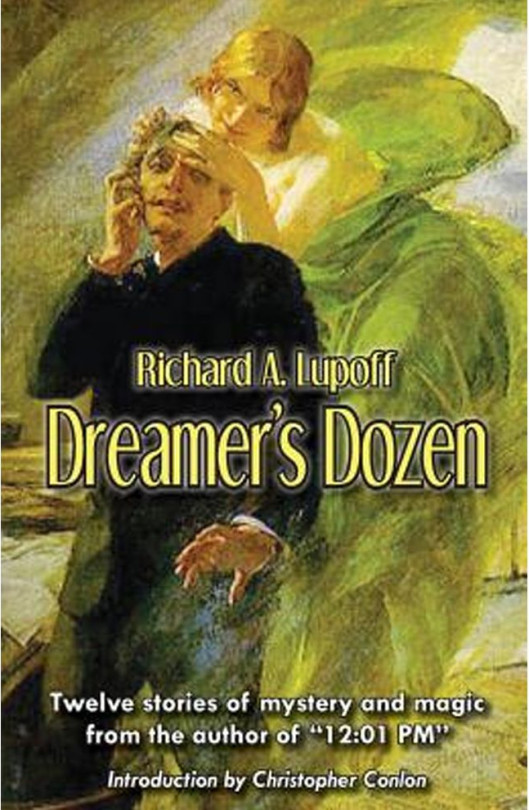Tachyon tidbits featuring James Morrow, Alastair Reynolds, Chris Tarry, and Richard A. Lupoff
The latest reviews and mentions of Tachyon titles and authors from around the web.

James Morrow, Alastair Reynolds (photo: Barbara Bella), Chris Tarry, and Richard A. Lupoff (George Katechis via Wikimedia Commons)
At AMAZING STORIES, Ira Nayman enjoys James Morrow’s forthcoming THE ASYLUM OF DR. CALIGARI.
James Morrow’s THE ASYLUM OF DR. CALIGARI is a short novel big on ideas.
Let’s get the obvious question out of the way from the start: yes, the title character is taken from Robert Wiene’s 1920 German expressionist film THE CABINET OF DR. CALIGARI. In fact, the description of the asylum, with its sharp, odd angles, could act as a description of any of the buildings in the film. More importantly, the basic story of the film (Caligari travels through Europe with a man he claimed to have kept in a somnambulistic trance for 15 years) is related at least twice in the novel.

Morrow’s use of language is precise. On the first page, for instance, there are two metaphors which foreshadow the violence that is to come. This starts with the novel’s opening sentence: “From its birth during the Age of Reason until its disappearance following the Treaty of Versailles, the tiny principality of Weizenstaat lay along the swampy seam between the German Empire and the Grand Duchy of Luxembourg like an embolism lodged in an artery.”
He also has fun with language. At one point, Wyndham describes his unfortunate meeting with Picasso as “Rube Descending a Staircase” (a reference to Marcel Duschamp’s “Nude Descending A Staircase,” which Morrow conveniently name-checked on the previous page). At another point, Caligari discusses convincing female patients who exhibit signs of uncontrolled female desire that they are actually Sisters of the Carmelite Order, calling them “nunphomaniacs.”
Language is also an important pointer to the themes of Morrow’s book, as when Caligari comments: “The aesthetic intensity of this war will be beyond imagination.” To the fraught question of whether art has any visible or lasting effect on society, Caligari answers with a resounding, “Yes!” However, one of the plots to undo his evil involves making a duplicate painting that inspires romantic lust, rather than blood lust, in those who see it, a ploy which works until it is discovered by Caligari. Could it be that good art can counteract bad art? Or, is it just that every art movement supplants the one that came before it, regardless of its social value? (Personally, I’m not that concerned about the social effects of art. For those of us who are enlightened or moved or merely entertained by art in the moment in which we encounter it, its value is self-evident.)
One of the joys of THE ASYLUM OF DR. CALIGARI is its portrayal of the intellectual ferment of the first two decades of the twentieth century. Discussions of the value of the new science of psychology, of non-expressionistic art forms, of philosophers such as Nietzsche and of the evolution of warfare are strewn throughout the story. Despite the horrors depicted in the novel, it portrays the early 1900s as an exciting time to live.

BOOKFORAGER praises Alastair Reynolds’ SLOW BULLETS.
For something only 182 pages long there’s a lot packed into this story, and a lot that is touched on that I want to know everything else about. Briefly, Reynolds presents us with a universe that, like in a lot of his other books, humanity has thoroughly inhabited, only for a catastrophic event to occur that changes all the rules. His main character, Scur, and her fellow inhabitants on the Caprice (the ship’s name is a nice touch) awake after this event both devastatingly ignorant of what has happened and the time that has passed, and more technologically advanced than any other remaining pockets of humanity. In a crippled ship. The ship’s inhabitants also have a war criminal and a stowaway on board, a terrifyingly malfunctioning auto-surgeon (best scene!!!), some serious ideological differences to overcome, and a desperate race to save what they can of their cultural and technological knowledge as the Caprice loses its capacity to hold onto that information. It’s great stuff!

THE UNEXPLAINABLE
DISAPPEARANCE OF MARS PATEL, created by Chris Tarry (whose story “Topics in Advanced Rocketry” graced INVADERS: 22 TALES FROM THE OUTER LIMITS OF LITERATURE), David Kreizman, Jenny Turner Hall, and Benjamin Strouse,
was awarded a prestigious Peabody Award.
An original, serialized podcast, THE UNEXPLAINABLE DISAPPEARANCE OF MARS PATEL Patel transports listeners to H.G. Wells Middle School to follow Mars Patel—a plucky but brilliant outcast prone to trouble—and his friends as they investigate the mysterious connection between disappearing kids and a billionaire inventor. With vivid characters and fast-paced storytelling, THE UNEXPLAINABLE DISAPPEARANCE OF MARS PATELrecaptures the best of golden age radio while also representing fresh and diverse young voices. The hero is an Indian-American son of a single mother, and one of his best friends is a gruff young girl who may well identify as a boy. Never preachy, the podcast artfully embodies both an old-fashioned sensibility and a modern outlook, while exploring timeless pre-adolescent themes. Crushes and misunderstandings collide with attack drones and spaceships, dramatizing beautifully the thrills and absurdities of growing up. For introducing a new generation to the wonders of audio storytelling, THE UNEXPLAINABLE DISAPPEARANCE OF MARS PATEL earns a Peabody Award.

PUBLISHERS WEEKLY likes Richard A. (THE BEST OF XERO and “12:01 PM”) Lupoff’s short story collection DREAMER’S DOZEN.
Fans of Hugo-winner Lupoff (Claremont Tales) will welcome this collection of 12 short stories, many of them pastiches (in a variety of genres) written with obvious affection for the originals. “Dead Winter,” a tribute to Rex Stout’s Nero Wolfe set in the late 1930s, features a detective named Caligula Foxx, though unlike the sedentary Wolfe, Foxx doesn’t hesitate to fire a gun at some fleeing bad guys during a car chase on the streets of New York. “Scorpion Men of Mars” contains prose that could have been written by Edgar Rice Burroughs himself (“Armed only with machetes, their flame-tempered blades honed from Venusian ironwood trees, the courageous sable-tressed Venusian maiden and I beat back our vegetable attackers”).

Not every selection is a hit, but a fair number of readers are likely to agree with Christopher Conlon’s assessment in his introduction that Lupoff is an “extraordinary literary chameleon.”

For more info on THE ASYLUM OF DR. CALIGARI, visit the Tachyon page.
Cover by Elizabeth Story
For more info about SLOW BULLETS, visit the Tachyon page.
Cover art by Thomas Canty
Design by Elizabeth Story
For more info on INVADERS: 22 TALES FROM THE OUTER LIMITS OF LITERATURE, visit the Tachyon page.
Cover art by Goro Fujita
Design by Elizabeth Story
For more about THE BEST OF XERO, visit the Tachyon page.
Cover by Larry Ivie
